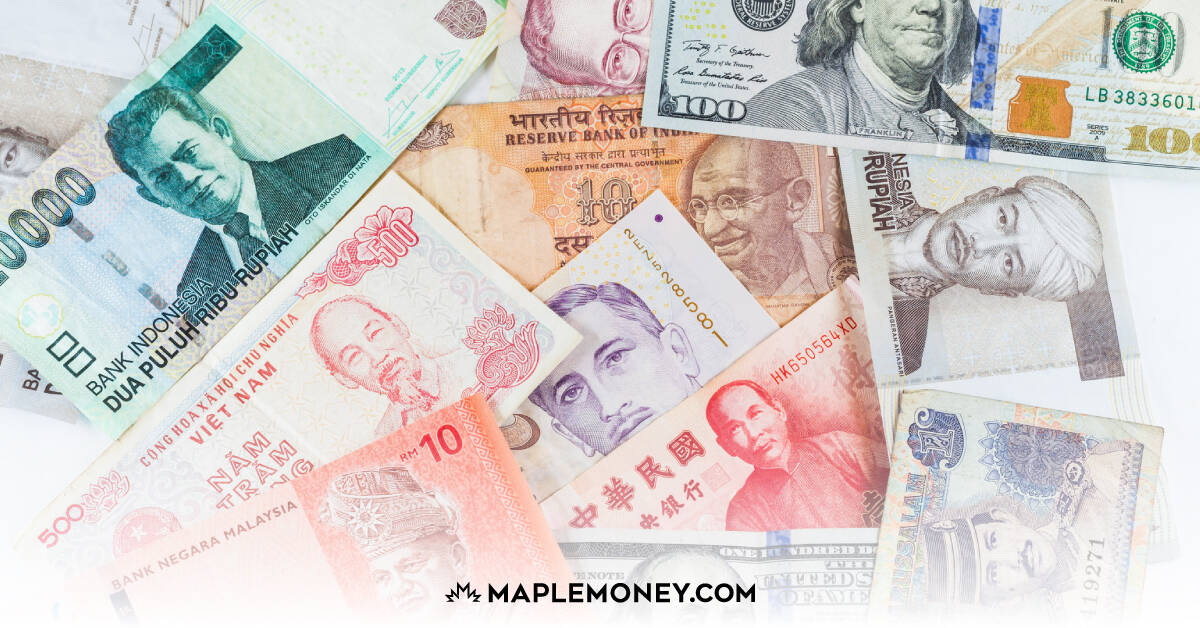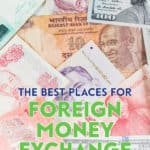The Best Places for Foreign Money Exchange

Planning a trip abroad? If you’re not careful, your budget can quickly be eaten up by high foreign exchange rates and fees. In this article, I’ll cover the many ways to exchange foreign currency, before or during your trip. In addition to showing you the cheapest ways to exchange money, I’ll let you know which currency exchange methods you should avoid.
Foreign Exchange – A Common Mistake
Many people think they can pick the best time to buy or sell foreign currency. As with investing, trying to time the markets is never a good idea. With any foreign exchange, the best approach is to plan ahead.
For example, if you’re planning a trip for which you’ll require a large amount of U.S. cash, and you’re not happy with the current exchange rate, you could decide to buy smaller amounts in regular intervals leading up to your trip. Trust me, trying to guess what direction the Canadian dollar is going to move, and when, is a fruitless effort.
Thankfully, regardless of what the Canadian dollar is trading at, you can always save money by finding better ways to buy and sell foreign currency. So, without further ado, here is my list of the best places to exchange money
No Foreign Exchange Fee Credit Cards
One of the easiest (and most convenient) ways to save on foreign exchange, is by using a credit card that waives the foreign exchange fee. For this, my top two choices are the Rogers World Elite Mastercard and the Scotiabank Passport Visa Infinite. Here’s a brief summary of what each card has to offer:
Rogers World Elite Mastercard
The Rogers World Elite is a no-fee, premium cashback credit card geared specifically for people who make a lot of purchases in a foreign currency ie. frequent travellers, or avid online shoppers. I should point out that this card doesn’t actually waive the 2.5% foreign exchange fee charged by most credit cards, instead, it pays a whopping 4% cashback on all purchases in a foreign currency.
This way, the cashback is enough to offset the 2.5% forex fee, while the cardholder benefits from a net 1.5% cashback. All without an annual fee. In addition, the several different types of insurance protection, including emergency medical, and trip cancellation and interruption coverage. I’ve included a list of features and benefits of the Rogers World Elite below, or for more information, you can check out my recent, in-depth review.
Features:
- Premium card, no annual fee
- $25 signup bonus
- 1.5% net cashback on all purchases in a foreign currency
- 2% cashback on Rogers purchases
- 1.75% cashback on all other spending
- 19.99% purchase interest / 22.99% cash advance interest
- Annual income threshold, $80,000/$150,000 household
- Private Lounge Access via Mastercard Airport Experiences
- Additional cards are free
Scotiabank Passport Visa Infinite
Unlike the Rogers World Elite, the Scotiabank Passport Visa Infinite actually waives the foreign exchange fee. Otherwise, it’s a premium Visa card that rewards customers when they spend on groceries, restaurants, entertainment, and transit. Another big perk to this card is the robust insurance coverage. It boasts more than 12 different types of travel and purchase protection. You can get more information on this foreign exchange friendly card in my detailed review of Scotiabank Rewards.
Features:
- Signup bonus of 30,000 Scotia Rewards Points ($300 value)
- 2 points earned for every dollar spent on groceries, restaurants, entertainment, transit
- 1 point earned on all other purchases
- Priority Pass access included, with 6 complimentary passes/year
- No foreign currency transaction fee
- $139 annual fee
- Minimum income requirement ($60,000/$100,000 household)
- 1 Free supplementary card ($50 value)
- 24/7 Concierge Service
- Includes 12 different types of travel and purchase insurance
Get a U.S. Dollar Credit Card
Another way to save on foreign exchange (when you’re travelling to the U.S.), is to avoid it altogether. Most Canadian banks offer a credit card that’s in U.S. dollars. This is different than a no foreign exchange fee card, in that no exchange actually occurs at the time of transaction.
To make a U.S. dollar card work, you’ll want to have a USD chequing account where you can accumulate U.S. dollars. When you need to pay off your credit card balance, you can transfer funds directly from your USD chequing account without any foreign exchange.
Of course, to get the money in your account, you’ll need to exchange CAD to USD at some point, but you have more control over when, and how you’ll exchange funds. A U.S. dollar credit card also helps in that it reduces the need to be carrying large amounts of U.S. cash when you’re across the border. Each of the Big Five banks offers a U.S. dollar credit card:
- TD U.S. Dollar Visa Card
- BMO U.S. Dollar Mastercard
- Scotiabank US Dollar Visa Card
- RBC U.S. Dollar Visa Gold
- CIBC U.S. Dollar Aventura Gold Visa Card
Use an Online Exchange
One of the cheapest ways to exchange money is through a dedicated online exchange. Because these companies buy and sell huge volumes of foreign currency in bulk, they are able to provide better rates, on average, than banks and credit unions. These companies are fully regulated and licensed to do business in Canada. Examples of online currencies would be KnightsbridgeFX and TransferWise. Here’s a more detailed look at Knightsbridge, which is headquartered in Toronto, and TransferWise.
Knightsbridge Foreign Exchange
KnightsbridgeFX provides online foreign exchange to Canadians at a better rate than what you would pay through your primary financial institution. In fact, they guarantee that they will beat any rate offered by your bank. According to Knightsbridge, you can book a forex transaction within minutes, and arrange for payment from your bank account. Knightsbridge promises same-day delivery, providing that you place your order prior to the daily cutoff.
One downside to Knightsbridge is that they have a minimum exchange threshold of $2,000, so you really can’t benefit from their service unless you’re exchanging lump sums of money.
TransferWise
TransferWise is a British company that makes it possible to send money around the world, at fees that are up to 8X less than what you would pay through your bank. When you open up a borderless account with TransferWise, you can quickly and easily send money to your recipient, in their local currency.
According to TransferWise, all that’s required is for you to deposit funds into your TW account, and exchange the funds into your selected currency at a rate that’s far lower than what your bank would charge (TransferWise does charge a small fee). Once the funds are converted, TransferWise will deposit into the recipient’s account on your behalf.
Norbert’s Gambit
Norbert’s Gambit is an investment strategy designed to avoid the spread that banks charge on CAD/USD foreign exchange transactions. If you’re an experienced investor who deals in larger volumes of currency exchange, Norbert’s Gambit could save you thousands of dollars over time.
Here’s the idea, in a nutshell. An investor buys shares of a stock or ETF on one exchange, then requests that their brokerage journal the shares over to the exact same listing in the foreign currency, at the market exchange rate, finally selling the shares in the currency that you want to end up with. In doing so, the only fees you should encounter would be the transaction fees of buying and selling the securities.
For more information, including how to execute it without paying any trading fees, here’s an article I wrote on Norbert’s Gambit.
Exchange Money Through Your Bank Branch
I suspect this is how most Canadians conduct foreign exchange, but it’s certainly not the cheapest way to go. On average, your bank branch is going to charge a higher rate on foreign exchange than the online methods that I described earlier (KnightsbridgeFx, TransferWise).
Here’s a tip, however. If you’re buying or selling U.S. dollars through your bank, open a USD chequing/savings account, and complete foreign exchange transactions on your own, via online banking. Most banks offer a slightly better exchange rate online because it’s not tying up expensive branch resources.
Exchange Money at an Airport or Hotel
I’m including this one in my list because it is certainly an option, but it’s not one I recommend. Many airports and hotels offer foreign exchange services, but they are incredibly expensive. You’ll often pay 10% or more in fees alone, over and above the exchange rate. Essentially, you’re paying for the convenience and the airport/hotel is betting that your options are limited. It’s a lot like buying food at a sporting event, or movie popcorn. That said, if you’re in a pinch, it is an option.
Foreign Exchange – Things to Avoid at all Costs
While there are many ways to exchange foreign currency, there are a few that you should avoid at all costs, because they’re either too expensive, a bit shady, or downright illegal. Of course, it goes without saying that whenever you travel abroad, be sure to take every precaution to protect yourself from theft, or fraud.
Dynamic Currency Conversion
When travelling abroad, many retailers will give you the option of paying in your home currency, meaning that they will do the exchange on their end, before you pay the bill. Never agree to this, as the exchange rates and fees they charge will always be higher than what you would pay using your own credit or debit card. When you’re presented with the option, always pay in the
Foreign Exchange Scams
Money exchange scams are becoming far too common, and it’s something you need to be aware of when you’re travelling. Always make sure you’re exchanging money through a reputable financial institution. Be wary of any individual who offers to exchange your money at a better rate than what the bank is offering. You could receive counterfeit funds in return, or have money stolen from you in the transfer process. You know what they say, “if it sounds too good to be true…”.
Foreign Currency Black Market
It should come as no surprise that there’s a thriving black market for foreign exchange. After all, anytime money can be made by circumventing the legal channels, there will be someone who’s willing to try. Taking part in a foreign currency black market is not only dangerous, but it could also result in your being caught, and arrested.
Do’s and Don’ts of Foreign Exchange
As you can see, there are many ways to exchange foreign currency. Unfortunately, only some will save you money. To summarize, I’ve created the following list of foreign exchange Do’s and Don’ts:
DO…
- apply for a credit card without foreign exchange fees.
- exchange lump sums through an online exchange ie. TransferWise
- use a U.S. dollar Visa to avoid exchanging altogether
- open a foreign currency bank account to accumulate/store funds
- consider Norbert’s Gambit (experience investors only)
DO NOT…
- time the market. No one knows what the value of the CDN dollar will be
- exchange money at an airport, or a hotel, unless it’s an emergency
- buy foreign currency at your bank branch
- use prepaid travel cards (high fees and service charges)
- allow retailers to do the currency conversion prior to making a purchase
- fall for a forex scam. Remember, if it’s too good to be true….


Comments
How about using an ATM at the destination? I have a Scotiabank account and I am going to Mexico. Would I get a better exchange rate at the bank machine?
Another caveat: foreign ATMs – never accept “currency conversion”- always process without. This will save you at least 5% or more depending on bank and location.